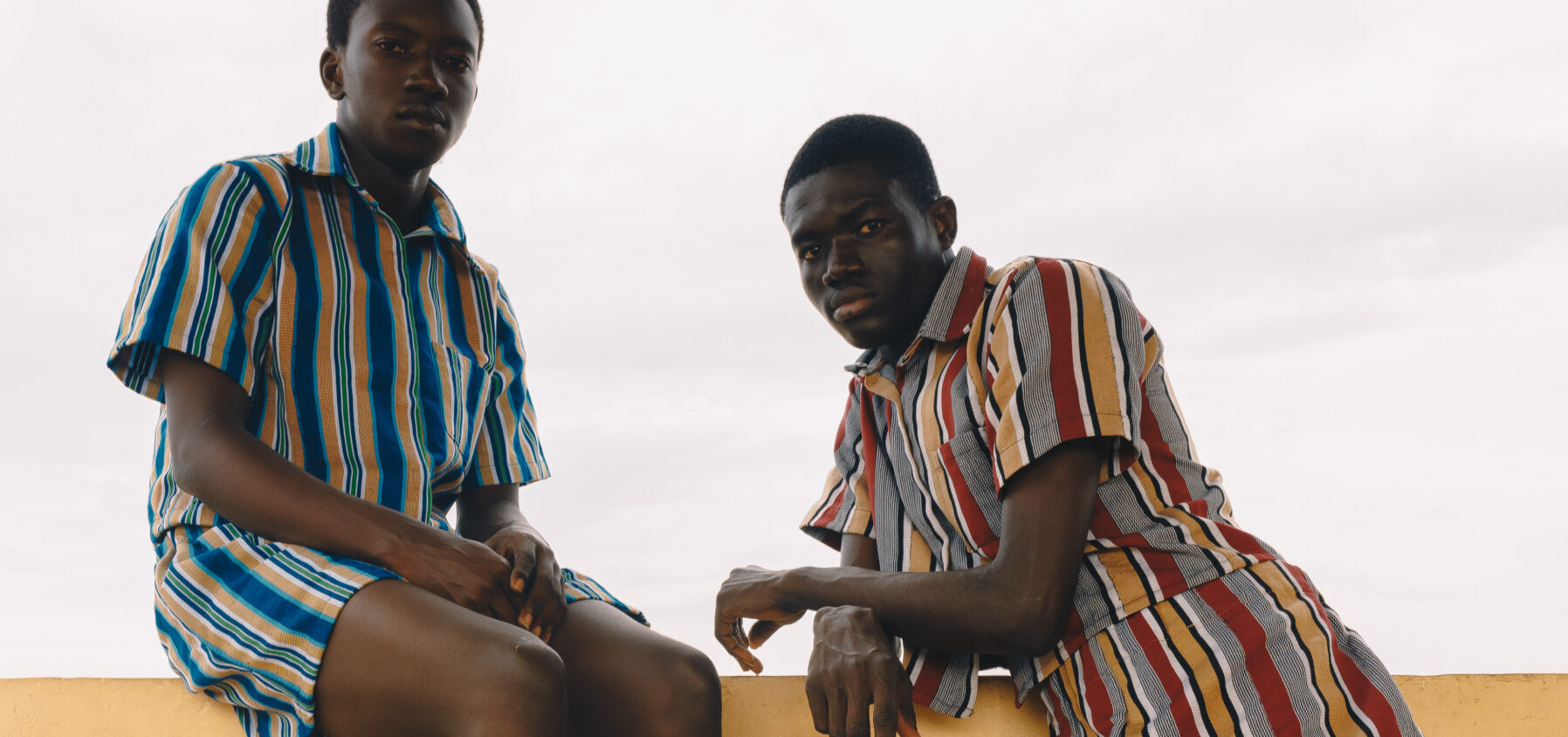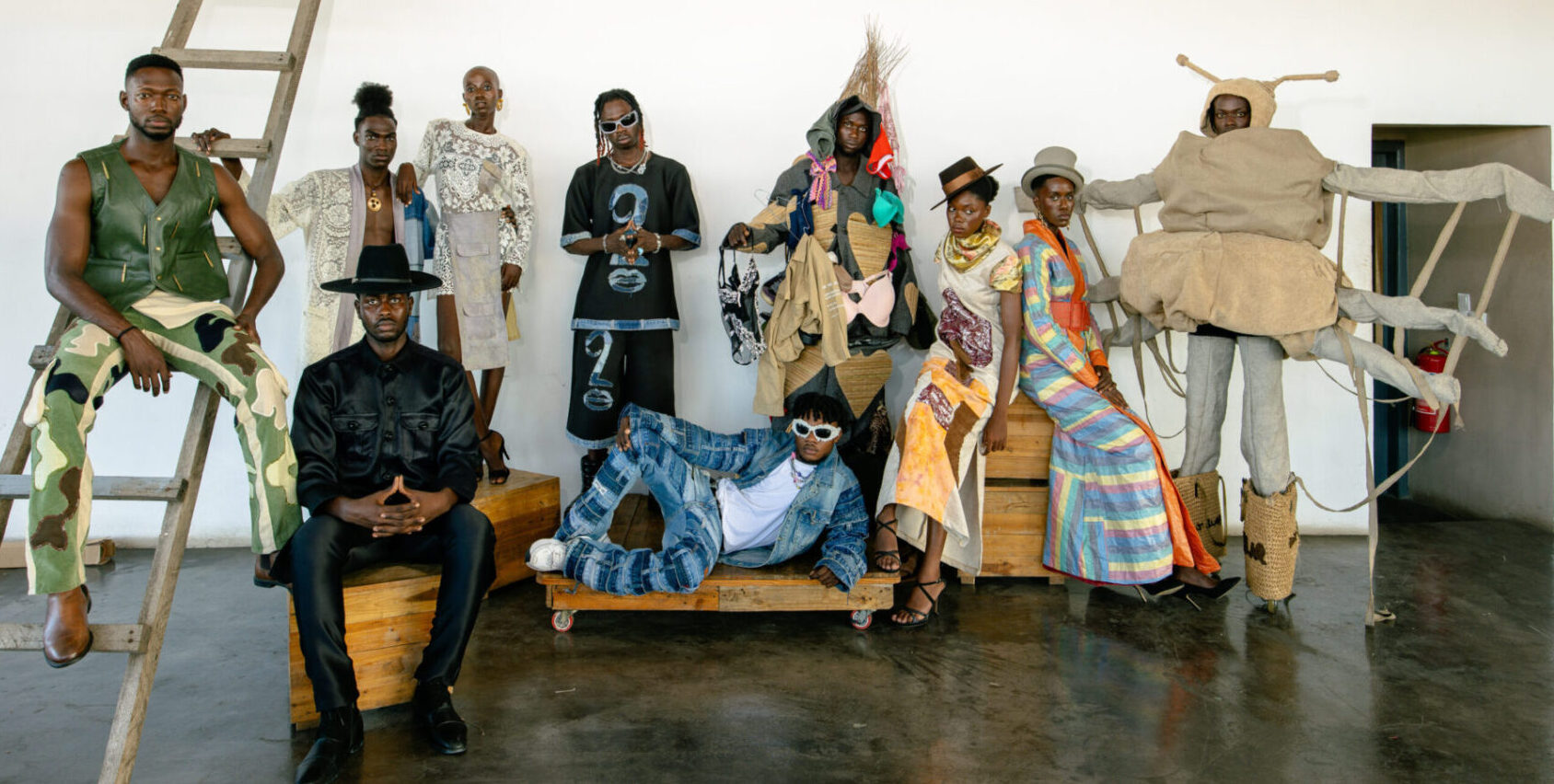WORDS Helen Jennings
Travis Obeng-Casper’s vision for turning Ghana’s textile heritage into a thriving national industry
With his burgeoning label Ajabeng, Travis Obeng-Casper is weave new traditions into Ghana’s textile traditions. Looking to heritage cloths such as kente and fugu, his inventive approach taps into their important role as archives of memory to create a global dialogue on style. “I believe in using textiles to have a meaningful conversation beyond our borders that draws attention back to Ghana’s true identity,” Obeng-Casper asserts. “Let’s celebrate these cloths, not by keeping them for formal attire, but by moving them forward and making them wearable for the every day.”

This Accra-based talent studied fashion at Radford University and debuted his first designs in 2018 at Accra’s Glitz Africa Fashion Week, his brand name taken from the nickname his mother used to call him, meaning ‘wise man’. He went on to officially launch in 2020 at Arise Fashion Week in Lagos, where judges included him in the top eight shows. Since then, Obeng-Casper’s minimalist, unisex collections have been influenced by everything from the sisterhood of Kayayei women (female porters in Ghana’s markets) and Mati Diop’s film ‘Atlantics’ to President Nkrumah’s love of highlife music and James Barnor’s photographic archives – each research-driven chapter more nuanced than the last. Attracting celebrity fans including Jidenna, Mr Eazi, Akan and Juls along the way, Ajabeng has become the go-to for refined tailoring with a nostalgic spirit.
“I’m a reserved person so I like clean, simple silhouettes. And coming from Africa, where brands are often known for being quite bold and loud, I like to think about how my storytelling can make the noise rather than the pieces themselves,” he says. “I often enjoy looking at photography from the post-colonial period and bringing that sense of optimism into contemporary fashion.”
Building on these foundations, Obeng-Casper has turned his attentions to the very roots of Ghanaian dress practices. “Our local handwoven textiles are durable but too heavy to wear in a modern way, so I wanted to make them softer and lighter.” His first step was to meet with celebrated multidisciplinary artist Kofi Setordji, board member at Nubuke Foundation and founder of the ArtHaus residency programme. He introduced Obeng-Casper to a weaver and together they began to explore new processes.
While finding locally produced, organic cotton in Ghana is challenging, they worked with a cotton manufacturer to source a raw, natural yarn and then studied different weaving techniques found around the country. “The Volta region, the Asante region and the northern region all have different weaving traditions including plains, stripes and symbols. We started with a plain technique and developed a cross-cultural weave that is recognisably Ghanaian,” he explains. “The result is a high-ranking textile that retains its cultural significance.”
“I believe in using textiles to have a meaningful conversation beyond our borders that draws attention back to Ghana’s true identity”
The first fruits of the collaboration can be seen in Ajabeng’s SS25 collection, ‘Heritage in Motion’. Key pieces such as loose-fit shirts and tailored pants are cut smartly yet softened by the earthy sensibility of the fabrication. “The collection serves as an invitation to embrace the harmonious blend of tradition and modernity, marking the beginning of a time filled with endless opportunities and lasting excellence,” he says.
Since then, Obeng-Casper and his team have continued to push forward, investigating new materiality such as pineapple yarn, introducing natural dyes and developing fresh weaving motifs – all the while ensuring the textiles remain fully biodegradable. This progress is seen in his latest AW25 collection, ‘Post Drip’, which takes inspiration from Célestin Monga’s ‘Nihilism and Negritude: Ways of Living in Africa’ – a series of essays surveying life on the continent and methods of finding meaning and joy in the chaotic and absurd. “The author reminds us that there are so many ways of thinking about Africa, and so many conversations to be had. The collection expresses that vibrancy while introducing colour to very functional pieces.”

The campaign, shot in Dakar, features oversized co-ords, button-downs and wide-leg shorts in burnt orange and mustard hues that beg to be worn with an easy elegance. The result of working with his peers across West Africa, the visual storytelling behind the brand is all part of the designer’s human-centred take on sustainability and community building. “For me, sustainability is about fair wage employment and ensuring everyone who is part of the brand is treated very well. It’s about using the best quality, natural fibres and fabrics and being committed to slow production. And it’s about working with our local creatives to communicate a global narrative. That’s how you sustain a brand and a business.”
Leading by example, and spurred on by the ethical efforts of his peers such as Larry Jay and LVMH semi-finalist David Kusi Boye-Doe, Obeng-Casper believes that Ajabeng is living proof of Ghana’s ability to revive its textile industry, which has been long damaged by the deluge of second-hand clothing and cheap imports from other parts of the world. “I want to speak with the government and with the private sector to present the evidence that Ghana can be a textile nation once more, using my brand to set the case for going back to our local textiles and bringing them into the future.”
His ultimate goal is to put in place the infrastructure for growth whereby everyone benefits. To that end, he’s established the Ntama Collective and is looking to establish a production hub in the Volta region. “We’re still in the development stage but I want to retrain more weavers, expand capacity, build a supply chain and work with other textile making experts such as Cabes in Burkina Faso. And then we’ll be in a position to put it on the national agenda.”
Mit seinem aufstrebenden Modelabel Ajabeng schreibt Travis Obeng-Casper an einer neuen Textilgeschichte Ghanas. Dabei greift er auf traditionelle Stoffe wie Kente und Fugu zurück – Stoffe, die mehr sind als nur Muster: Sie sind Archive des kollektiven Gedächtnisses. Obeng-Casper nutzt sie, um einen globalen Dialog über Mode zu führen. „Ich glaube daran, mit Textilien bedeutungsvolle Gespräche über Grenzen hinweg anzustoßen – Gespräche, die Ghanas wahre Identität in den Mittelpunkt rücken“, sagt er. „Wir sollten diese Stoffe feiern, nicht indem wir sie nur zu festlichen Anlässen tragen, sondern indem wir sie in unseren Alltag holen.“
Der in Accra lebende Designer studierte Mode an der Radford University und präsentierte seine ersten Entwürfe 2018 bei der Glitz Africa Fashion Week. Der Name seines Labels geht auf den Spitznamen zurück, den ihm seine Mutter einst gab – Ajabeng, der „weise Mann“. Den offiziellen Startschuss setzte er 2020 bei der Arise Fashion Week in Lagos, wo seine Show es unter die besten acht schaffte. Seitdem verwebt Obeng-Casper Einflüsse aus ganz unterschiedlichen Quellen: von den Kayayei, den Lastenträgerinnen der Märkte, über Mati Diops Film Atlantics, bis hin zu Präsident Nkrumahs Liebe zur Highlife-Musik und den Archivfotografien von James Barnor. Jede Kollektion ist ein neues Kapitel, durchdacht, forschungsbasiert, nuanciert.
Prominente wie Jidenna, Mr Eazi, Akan oder Juls zählen längst zu seinen Fans. Denn Ajabeng steht für zurückhaltende Eleganz mit einem Hauch Nostalgie – maßgeschneidert, unisex, minimalistisch.
„Ich bin ein ruhiger Mensch, ich mag klare, einfache Silhouetten“, sagt er. „In Afrika sind viele Marken laut und bunt. Ich versuche, die Geschichte sprechen zu lassen – nicht das Kleidungsstück.“ Seine Inspirationsquelle: Fotografien aus der postkolonialen Zeit – ihre Aufbruchsstimmung überträgt er ins Jetzt.
Doch Obeng-Casper will tiefer gehen. An die Wurzeln ghanaischer Kleidung. „Unsere handgewebten Stoffe sind robust, aber oft zu schwer für moderne Schnitte. Ich wollte sie weicher, leichter machen.“ Der erste Schritt: ein Treffen mit Kofi Setordji, Künstler, Kurator und Mitbegründer des ArtHaus-Residenzprogramms. Er stellte den Kontakt zu einem Weber her – der Beginn einer fruchtbaren Zusammenarbeit.
Gemeinsam suchten sie nach regional produzierter Baumwolle – keine leichte Aufgabe in Ghana – und fanden schließlich einen Hersteller, der unbehandelte Naturgarne liefern konnte. Dann begannen sie, Webtechniken aus den verschiedenen Regionen des Landes zu erforschen: vom Volta-Gebiet über Asante bis in den Norden. „Jede Region hat eigene Muster – Streifen, Symbole, einfache Flächen“, erzählt Obeng-Casper. „Wir begannen mit einem schlichten Gewebe und entwickelten daraus ein Muster, das als ghanaisch erkennbar ist – aber über Kulturen hinweg funktioniert.“ Das Ergebnis: ein hochwertiger Stoff mit kultureller Tiefe.
In Ajabengs Frühjahr/Sommer-Kollektion 2025, Heritage in Motion, zeigen sich die ersten Ergebnisse: locker geschnittene Hemden, feine Hosen – klar konturiert, aber mit der Erdigkeit des neuen Materials geerdet. „Diese Kollektion ist eine Einladung, die Harmonie zwischen Tradition und Moderne zu umarmen. Sie markiert einen Anfang – voller Möglichkeiten, voller Exzellenz.“
Doch damit ist es nicht getan. Obeng-Casper und sein Team experimentieren weiter – mit Fasern aus Ananas, mit Naturfärbung, mit neuen Webmustern. Immer mit dem Ziel, vollständig biologisch abbaubare Stoffe zu schaffen. Seine aktuelle Herbst/Winter-Kollektion 2025 trägt den Titel Post Drip – inspiriert von Célestin Mongas Essayband Nihilism and Negritude: Ways of Living in Africa. Eine Reflexion über Sinnsuche im Absurden, über Lebensfreude trotz Chaos. „Monga zeigt, dass es so viele Arten gibt, über Afrika zu denken – und noch mehr, um darüber zu sprechen“, sagt Obeng-Casper. „Diese Kollektion bringt diese Lebendigkeit zum Ausdruck – mit funktionaler Kleidung in kräftigen Farben.“
Für die Kampagne reiste er nach Dakar. Weite Shorts, lässige Hemden, gedeckte Töne in Orange und Senfgelb – getragen mit einer selbstverständlichen Eleganz. Das Storytelling, so wichtig wie das Design selbst, entsteht in Kollaboration mit Kreativen aus Westafrika. Für Obeng-Casper bedeutet Nachhaltigkeit vor allem eines: Menschen ins Zentrum zu stellen. „Es geht um faire Löhne, um respektvollen Umgang mit allen, die am Label beteiligt sind. Um hochwertige Naturmaterialien. Und um langsame, überlegte Produktion. Das ist die Basis für eine nachhaltige Marke – und eine nachhaltige Gemeinschaft.“
Diesen Weg geht er nicht allein. Neben ihm stehen Designer wie Larry Jay oder David Kusi Boye-Doe, der es ins Halbfinale des LVMH Prize schaffte. Gemeinsam zeigen sie, dass Ghana sein Textilerbe wiederbeleben kann – trotz der Flut an Secondhand-Kleidung und Billigimporten. „Ich will mit der Regierung sprechen, mit der Privatwirtschaft – und zeigen, dass Ghana wieder ein Textilland werden kann. Mein Label ist der Beweis.“
Und er denkt weiter. In Strukturen, in Zukunftsszenarien. Mit dem Ntama Collective und Plänen für ein Produktionszentrum in der Volta-Region möchte er die Infrastruktur für Wachstum schaffen – für alle. „Wir sind noch in der Entwicklungsphase, aber ich will mehr Weber:innen ausbilden, Kapazitäten erweitern, Lieferketten aufbauen, mit anderen Textilinitiativen zusammenarbeiten, etwa mit Cabes in Burkina Faso. Und wenn das steht – dann gehört das Thema auf die nationale Agenda.“


